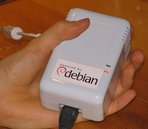Boot process of Debian on plug computers

This page describes the complete boot process of plug computers (such as SheevaPlug) running Debian. While the information from this document is not needed to run Debian on your plug computer, some users might find it interesting to know what's going on behind the scenes.
Debian Variants
Since Debian is a very popular distribution for plug computers, there are a lot of different instructions on the Internet explaining how to install Debian. Furthermore, some plug computers come with a variant of Debian pre-installed. While these systems are variants of Debian, they can differ quite significantly to the Debian you get when you use the official installation method, Debian's installer (known as debian-installer). This page covers installations made with Debian's installer.
Since a lot of pre-installed Debian variants replace the Linux kernel shipped by Debian with their own, a good way to verify that you're running a Debian system created by Debian's installer is to check whether you're running a Debian kernel. To check the kernel version, issue this command:
uname -r
If the result is in the form 2.6.XX or 2.6.XX.YY, then you're not
running a Debian kernel and the description of the boot process on this
page will not apply to your device.
The correct result for the official Debian kernel is in the form
4.XX.YY-Z-marvell (or 3.XX.YY-Z-kirkwood for older versions): 4.XX.YY
indicates the upstream version of the Linux kernel, Z indicates the
kernel ABI in Debian and marvell is the name of the kernel flavour. The
kernel ABI is changed whenever we make an incompatible change to the
kernel. In addition to the kernel ABI, the Debian kernel also has a
version. The specific version of the kernel you're running can be found in
/proc/version. This file contains the string Debian 4.XX.YY-ZZ in
brackets where ZZ is the revision of the Debian kernel.
Booting Debian
The boot loader used on plug computers is called u-boot. When you turn
your plug computer on, u-boot is called and will initialize the hardware.
It will then call the commands listed in the bootcmd environment variable
in order to boot. The settings of this variable depends on the type of
storage device you're booting from. Let's use USB as an example to explain
the u-boot variables used to boot Debian. There are three variables
(bootargs_console, bootcmd_usb and bootcmd) that are relevant:
| Variable | Setting |
|---|---|
bootargs_console |
console=ttyS0,115200 |
bootcmd_usb |
usb start; ext2load usb 0:1 0x00800000 /uImage; ext2load usb 0:1 0x01100000 /uInitrd |
bootcmd |
setenv bootargs ${bootargs_console}; run bootcmd_usb; bootm 0x00800000 0x01100000 |
During the boot process, each command listed in bootcmd is
executed. There are three commands:
- The first command (
setenv bootargs ${bootargs_console}) sets thebootargsvariable to the value of thebootargs_consolevariable. In the example,bootargs_consoleis set toconsole=ttyS0,115200sobootargswill receive this setting. When the Linux kernel is booted, thisbootargsvariable is passed to the kernel. As a result,console=ttyS0,115200will be passed to the Linux kernel and this will ensure that the serial console will work under Linux. Typically we would also set arootparameter to indicate the root device. However, this is usually not necessary for Debian on plug computers since we put the name of the root device into the ramdisk (see below). You only have to set arootparameter when you want to move your installation to another storage device. - Second, the command
run bootcmd_usbcauses the commands listed in thebootcmd_usbvariable to be executed (or similar commands for SATA and MMC/SD). This variable consists of three commands: The first command (usb start) initializes the USB system (or SATA/MMC). The second command (ext2load usb 0:1 0x00800000 /uImage) loads the kernel(/uImage) from USB partition0:1to RAM (at location0x00800000). Finally, the ramdisk (/uInitrd) is loaded to RAM (at location0x01100000). - Finally, the
bootmcommand tells u-boot to execute the Linux kernel and ramdisk from RAM. A ramdisk is a small Linux system that is executed in RAM and which is used to boot the full Debian system from disk. The ramdisk includes drivers that are required to boot Debian from disk, such as filesystem and storage modules.
At this point, the boot process is the same as with any other Debian
system. The only difference is that the ramdisk on plug computers contains
the name of the root device (but it can be overridden with a root
parameter passed to the kernel).
Upgrading the Linux kernel in Debian
When you install a new version of the Debian kernel package, a number of steps are performed automatically in order to make sure you can boot the new kernel:
- When you install a kernel package, the file
/boot/vmlinuz-$VERSIONis installed and modules are installed under/lib/modules/$VERSION($VERSION indicates the output ofuname-rfrom the new kernel). - The program
initramfs-toolsis called to generate the ramdisk on disk (/boot/initrd.img-$VERSION). During the ramdisk generation, the script/usr/share/initramfs-tools/hooks/flash_kernel_set_rootis called on plug computers to write the name of the root device to the ramdisk. - Finally,
flash-kernelis called to activate the new kernel. Despite the name,flash-kerneldoes not write the kernel to flash on plug computers. Instead, it takes the kernel (/boot/vmlinuz) and ramdisk (/boot/initrd.img) and generates u-boot images (/boot/uImageand/boot/uInitrd, respectively) out of them with the help ofmkimage. This step is required because u-boot cannot load the kernel and ramdisk directly and requires special images made withmkimage.